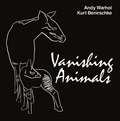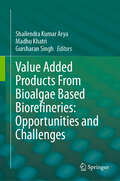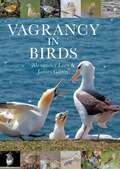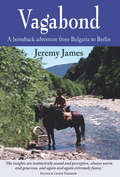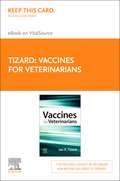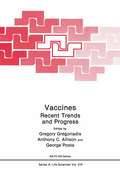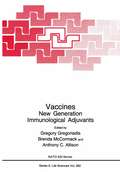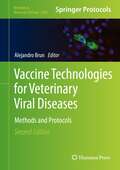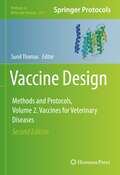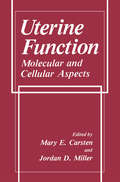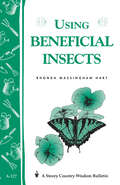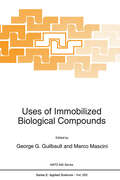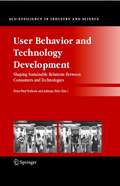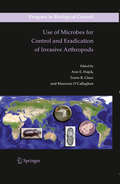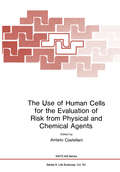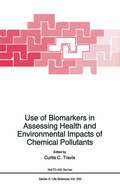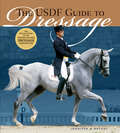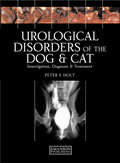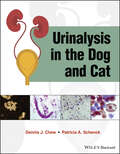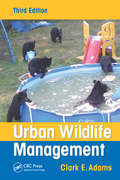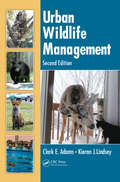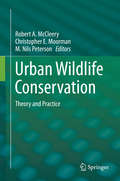- Table View
- List View
Vanishing Animals
by Andy Warhol Kurt BenirschkeEspecially for this book, Andy Warhol has created prints (silkscreen over collage) of some of the most endangered animals in the world. Here they are joined with a stimulating text by Dr Kurt Benirschke affording the reader an opportunity to discover the lives and habits of these animals and what the outlook is for their survival.Extinction, the tragic and permanent loss of entire species of animals, should be a concern for everyone This concern and a strong desire to take action toward preventing the loss of more animals has brought about an unusual collaboration between art and science. The result is this beautiful volume in which artist and scientist have joined efforts to inform and inspire others to take action. It is hoped that these fascinating and striking portrayals will stimulate readers to join their own energies and talents to this important fight against the loss of more species. This book brings some of the less well known endangered animals to the reader's attention. These animals deserve just as much attention as the giant panda or the mountain gorilla about which so much has already been said. Naturally, the animals presented here are very personal choices, having been selected from a virtually endless supply of animals whose last hour is rapidly approaching.
Value Added Products From Bioalgae Based Biorefineries: Opportunities and Challenges
by Shailendra Kumar Arya Madhu Khatri Gursharan SinghThis book covers wide aspects of algal technology and algae-based biorefinery aspects. Algae are the most prevalent, primitive, and abundant microbes on Earth, however, the commercialization of algal-based value-added products is still low due to the negligible dissemination of knowledge flow among the stakeholders and researchers.This book provides up-to-date information on the cultivation of microalgae, their harvesting, downstream processing, and diverse applications. It further discusses the macromolecules existing in microalgae, such as proteins, carbohydrates, and lipids, poly-unsaturated fatty acids, peptides, exo-polysaccharides, flavonoids and antioxidants. This book also highlights the advantages and some real-time challenges before the establishment of sustainable algal-based biorefineries. Further, it includes clear flow charts and figures in each chapter to aid in interpretation of every technical concept. This book motivates readers, entrepreneurs, and young farmers to exploit easily growing microalgae through cottage to large-scale biorefineries and start their own businesses for the production of value-added products.
Vagrancy in Birds
by Alexander Lees James GilroyThe first comprehensive coverage of a subject that has fascinated natural historians for centuries.Avian vagrancy is a phenomenon that has fascinated natural historians for centuries. From Victorian collectors willing to spend fortunes on a rare specimen, to today's high-octane bird-chasing 'twitchers', the enigma of vagrancy has become a source of obsession for countless birders worldwide.Vagrancy in Birds explores both pattern and process in avian vagrancy, drawing on recent research to answer a suite of fundamental questions concerning the occurrence of rare birds. For each avian family, the book provides an in-depth analysis of recent and historical vagrancy patterns, representing the first comprehensive assessment of vagrancy at a global scale. The accounts are accompanied by hundreds of previously unpublished images featuring many of the most exceptional vagrants on record.The book synthesises for the first time everything we know about the subject, making the case for vagrancy as a biological phenomenon with far-reaching implications for avian ecology and evolution.
Vagrancy in Birds
by Alexander Lees James GilroyThe first comprehensive coverage of a subject that has fascinated natural historians for centuries.Avian vagrancy is a phenomenon that has fascinated natural historians for centuries. From Victorian collectors willing to spend fortunes on a rare specimen, to today's high-octane bird-chasing 'twitchers', the enigma of vagrancy has become a source of obsession for countless birders worldwide.Vagrancy in Birds explores both pattern and process in avian vagrancy, drawing on recent research to answer a suite of fundamental questions concerning the occurrence of rare birds. For each avian family, the book provides an in-depth analysis of recent and historical vagrancy patterns, representing the first comprehensive assessment of vagrancy at a global scale. The accounts are accompanied by hundreds of previously unpublished images featuring many of the most exceptional vagrants on record.The book synthesises for the first time everything we know about the subject, making the case for vagrancy as a biological phenomenon with far-reaching implications for avian ecology and evolution.
Vagabond: A Horseback Adventure from Bulgaria to Berlin
by Jeremy JamesThe journey starts when author and long-rider Jeremy James buys two horses from gypsies at a fair in southern Bulgaria. He and his long-suffering friend Chumpie then set off on horseback, winding northwards to Berlin, and on the way they encounter a marvellous array of local characters from all walks of life as they ride from Bulgaria to Berlin, via Romania, Hungary, Czechoslovakia and Poland. On a low budget, they are sustained by local fire-water, indigestible food and the forceful personalities of their horses who steal, run away, misbehave or suddenly comply at will and add a whole new dimension to the experience of travel. After five long months, they finally reach their destination. It has taken Jeremy through an Eastern Europe full of surprises, which, with the collapse of communism, has almost disappeared today.
Vaccines for Veterinarians E-Book
by Ian R. TizardBoth a theoretical text and a practical handbook, Vaccines for Veterinarians is the first of its kind to bring the basic science of animal vaccination and the practical details of vaccine use together in one single volume. From the first chapter on the history of vaccination and the triumph of rinderpest eradication to the last chapter on the rapidly emerging field of cancer vaccines, this book offers a truly comprehensive grounding in established and emerging vaccines for both major and minor species. Specific topics include viral vectored vaccines, DNA-plasmid vaccines, RNA vaccines, reverse vaccinology, the complexities of adjuvant use, vaccine failures and adverse events, vaccine production and regulation, robotic vaccination machines, contraceptive and production-enhancing vaccines, and so much more. At a time when resistance to human vaccination is receiving much publicity, this evidence-based book is the ideal counter to ill-informed speculation — serving as a timely reminder that vaccination is essential for the control of infectious diseases in animals.Well-respected and experienced veterinary author, Ian Tizard, provides expert guidance on the topic of vaccinations and immunology in veterinary medicine.Expert Consult site offers an online version of the book, making it easy to search the entire book electronically. The latest information on viral vectored vaccines keeps you up-to-date on the topic as well as the properties and relative advantages of currently used vectors in animal vaccines.Survey of vaccine responses covers the different mechanisms by which the immune system responds to different types of vaccines.Inclusion of the latest vaccine technologies discusses the advantages and disadvantages of DNA-plasmid vaccines, RNA vaccines, and more.Coverage of adverse events and hypersensitivities includes the best ways to treat them and report them.Coverage of passive immunization discusses the growing use of therapeutic monoclonal antibodies in veterinary medicine.Coverage of immunotherapy includes recent improvements and new products in both active and passive immunotherapy against animal cancers.
Vaccines: Recent Trends and Progress (Nato Science Series A: #215)
by Anthony C. Allison Gregory Gregoriadis George PosteThe success of vaccination in controlling infectious diseases is well documented. However, low profitability, expense and liability have hindered research and development of vaccines. Recently, increasing realization (enhanced by the AIDS pandemic) of the need to overcome such difficulties has led to steps being taken by national authorities, non-profit and commercial organizations to resolve them. This has been facilitated by developments in recombinant DNA techniques, the advent of monoclonal anti bodies and progress in the understanding of the immunological structure of proteins which have laid the foundation of a new generation of vaccines. Such vaccines are defined at the molecular level, can elicit immune responses controlling infectious organisms and are therefore potentially free of the problems encountered in conventional ones. Unfortunately, subunit and synthetic peptide vaccines are often only weakly or non inmunogenic. However, developments in both antigen production and immuno potentiation of weak antigens have opened new avenues with exciting prospects for vaccine design.
Vaccines: New Generation Immunological Adjuvants (Nato Science Series A: #282)
by Gregory Gregoriadis Brenda McCormack Anthony C. AllisonDuring the last decade or so vaccine development has been facilitated by rapid advances in molecular and cell biology. These have laid the foundations of a new generation of vaccines exemplified by subunit vaccines produced through gene cloning and by synthetic peptides mimicking small regions of proteins on the outer coat of viruses. Such peptide~ are capable of eliciting virus-neutralizing antibodies. Unfortunately, subunit and peptide vaccines are only weakly or non immunogenic in the absence of immunological adjuvants that are known to augment specific cell-mediated immune responses to the antigens and to promote the formation of protective antibodies. This book contains the proceedings of the 4th NATO Advanced Studies Institute (ASI) "Vaccines: New Generation Immunological Adjuvants" held at Cape Sounion Beach, Greece, during 24 June -5 . July 1994 and deals in depth with both theoretical and practical aspects of vaccinology. These include the role of antigen presenting cells in the induction of immune responses. immunopotentiation by a variety of new generation immunological adjuvants and vaccine carriers. and recent advances and perspectives in experimental vaccines as well as vaccinatioll with nucleic acids. We express our appreciation to Dr. K. Dalsgaard and Dr. J. L. Virelizier for their cooperatioll in planning the ASI and to Mrs. Concha Pening for her excellent production of the manuscripts. The ASI was held under the sponsorship of NATO Scientific Affairs Division and generously co-sponsored by SmithKline Beecham Pharmaceuticals (Philadelphia).
Vaccine Technologies for Veterinary Viral Diseases: Methods and Protocols (Methods in Molecular Biology #2465)
by Alejandro BrunThis second edition includes a collection of antigen production and delivery strategies for vaccine development in veterinary species. New and updated chapters guide readers through protocols for antigen production, experimental antigen delivery and the analysis of immune responses upon vaccination. Written in the format of the highly successful Methods in Molecular Biology series, each chapter includes an introduction to the topic, lists necessary materials and reagents, includes tips on troubleshooting and known pitfalls, and step-by-step, readily reproducible protocols. Authoritative and cutting-edge, Vaccine Technologies for Veterinary Viral Diseases: Methods and Protocols, Second Edition aims to be a useful and practical guide to researches to help further their study in this field.
Vaccine Design: Methods and Protocols, Volume 2. Vaccines for Veterinary Diseases (Methods in Molecular Biology #2411)
by Sunil ThomasThis volume provides a practical guide providing step-by-step protocol to explore vaccines for farm and companion animals, as well as for fish and insects. Divided into three volumes, Volume 2: Vaccines for Veterinary Diseases guides readers through veterinary vaccines, vaccines for poultry, vaccines for farm animals, and vaccines for veterinary parasites. Written in the format of the highly successful Methods in Molecular Biology series, each chapter includes an introduction to the topic, lists necessary materials and reagents, includes tips on troubleshooting and known pitfalls, and step-by-step, readily reproducible protocols. Authoritative and practical, Vaccine Design: Methods and Protocols, Second Edition, Volume 2: Vaccines for Veterinary Diseases aims to be a useful practical guide to researchers to help further their study in this field.
Uterine Function: Molecular and Cellular Aspects
by M. E. Carsten J. D. MillerThe frontispiece, Leonardo da Vinci's drawing of the embryo in the womb, was chosen as a starting point for this book. It was Leonardo who in his notebooks and drawings combined artistic composition and accurate recording of the anatomy of the human body. Leonardo studied human anatomy in order to execute artistic drawings. His aim was to clarify form and function of human organs including reproductive organs. He followed up his extensive research with graphic representa tion and thereby initiated record keeping as a basis of scientific investigation. His records, accurate three-dimensional drawings, allowed others to reproduce his find ings and to test for correctness. Results could be updated and refined. Only after these steps can abnormalities be ascertained and defined as pathology. Though Leonardo was both artist and scientist, it is assumed that his anatomic drawings were used to improve his art, and thus scientific endeavor was at the service of his art. Anatomy, the offspring of science and art, is an integration of the two and became an accepted branch of the natural sciences. Although art and science continued to interact throughout the Renaissance, art was often placed in the service of science. In the course of history that followed, art and science in creasingly followed separate ways.
Using Beneficial Insects: Storey's Country Wisdom Bulletin A-127 (Storey Country Wisdom Bulletin)
by Rhonda Massingham HartSince 1973, Storey's Country Wisdom Bulletins have offered practical, hands-on instructions designed to help readers master dozens of country living skills quickly and easily. There are now more than 170 titles in this series, and their remarkable popularity reflects the common desire of country and city dwellers alike to cultivate personal independence in everyday life.
Uses of Immobilized Biological Compounds (NATO Science Series E: #252)
by George G. Guilbault Marco MasciniIn Uses of Immobilized Biological Compounds the reader will find a comprehensive survey of the field written by acknowledged experts who met in Brixen, Italy, between May 9 and 14, 1993 for a NATO Advanced Research Workshop devoted to the topic. The resulting volume presents a critical review of the latest results in the area and sets guidelines for future research. The 53 reports presented here cover: (A) General Aspects of Immobilizing Biological Compounds; (B) Medical, Clinical and Pharmaceutical Applications; (C) Electrochemical Biosensors; (E) Defense Applications; (F) Immunosensors and Receptors; (G) Food, Environmental, Clinical and Analytical Applications; and (H) Biotechnology and Marketing. In short, all aspects of the area are presented, in a compact format which will appeal to undergraduates, technicians, and professional scientists in the food, clinical, environmental, pharmaceutical and industrial fields.
User Behavior and Technology Development: Shaping Sustainable Relations Between Consumers and Technologies (Eco-Efficiency in Industry and Science #20)
by Peter-Paul Verbeek Adriaan SlobEnvironmental policy has long been determined by a dichotomy between technology and behavior. This book explores the relationships between technology and behavior from an interdisciplinary perspective. It is the first volume that aims to create a conceptual basis for analyzing interactions between technology and behavior, and to provide insights that are relevant to technology design and environmental policy.
Use of Microbes for Control and Eradication of Invasive Arthropods (Progress in Biological Control #6)
by Maureen O'Callaghan Ann Hajek Travis GlareThe Use of Human Cells for the Evaluation of Risk from Physical and Chemical Agents
by AmletoCastellaniIn this volume are collected 30 papers, 9 round table discus sions and 11 communications presented at the ASI Course on "The use of human cells for the evaluation of risk from physical and chemical agents", sponsored by NATO and organized by ENEA. The aim of the Course was to present different scientific ap proaches and technical advices in order to get dose-effect relation ships which are the basis for risk evaluation. The scientific back ground which is behind this approach was extensively discussed. Emphasis has been given to the use of human cells or human data in order to attempt to have a correct and realistic evaluation of the damage in humans. There are many criticisms on the use of animal data for human risk evaluation because of differences between species and between strains within the same species: differences in metabolism, activa tion processes and DNA repair ability makes uncertain the extrapola tion of animal data to humans. Also data obtained using specific strains or highly inbred strains in order to reduce the variance are not applicable due to the heterogeneity of the human population connected with individual responses. In this respect only the use of human cells enable us to detect the individual variability and to identify sensitive subpopu lations that would be at greater risk. My appreciation to Pieranita and Alberto Castellani for the as sistance during the meeting and to Giuseppe Biondi for his help in some of the editorial work.
Use of Biomarkers in Assessing Health and Environmental Impacts of Chemical Pollutants (Nato Science Series A: #250)
by Curtis C. TravisBiological markers (biomarkers) are useful tools for understanding the nature and extent of human exposure and risk from environmental toxicants. Biomarkers are classified into three basic categories: exposure, effect, or susceptibility. A marker of exposure is the product of the interaction between a target cell or molecule and a foreign substance (NAS, 1989). These markers can be used to determine the biologically effective dose necessary to elicit a particular physiological change in an organism. A marker of effect is a biochemical or physiological change in an organism that can predict the onset of adverse health effects resulting from a given exposure. Lastly, markers of susceptibility act as indicators of an inherent or acquired tendency of an organism to experience an adverse health effect (NAS, 1989). These markers are already used to detect a variety of diseases and show great promise for developing a better understanding of the mechanicisms of disease. Additionally, biomarkers can be used to establish a more rational basis for quantitative risk extrapolation between species, as weIl as to obtain more precise estimates of the time of critical exposure. These markers can also prove helpful in identifying potentially damaging exposures before the onset of adverse health effects. Biomarkers serve as a valuable exposure assessment tool because they take into account exposure from all routes and integrate exposure from all sources. They have the potential to yield better risk estimates than current monitoring and modeling protocols. In lune 1992, Dr. Travis and Dr.
The USDF Guide to Dressage: The Official Guide of the United States Dressage Foundation
by Jennifer O. BryantWhatever your primary equestrian discipline, dressage is an ideal way for you to increase your riding awareness and enhance your relationship with your horse. Providing an overview of basic techniques and a series of helpful training exercises, Jennifer O. Bryant stresses the tenets of harmonious communication between horse and rider as she guides you through the graceful movements of dressage. With suggestions on how to find qualified instructors and information on necessary equipment, this comprehensive guide will inspire you to explore this exciting and rewarding world.
Urological Disorders of the Dog and Cat: Investigation, Diagnosis, Treatment
by Peter Holt Alasdair Hotson-MooreThis book provides veterinary practitioners and trainees with a concise, systematic guide to urological disorders affecting dogs and cats. The author focuses first on assessment of the patient and the main investigative techniques to reach a diagnosis. He then deals with the differential diagnosis, causes and treatment of conditions ranging from pr
Urinalysis in the Dog and Cat
by Dennis J. Chew Patricia A. SchenckUrinalysis in the Dog and Cat A comprehensive up to date textbook for performing and interpreting urinalysis in dogs and cats with content that remains accessible to those in primary care and specialty practices. In Urinalysis in the Dog and Cat, a logical sequence to collection of urine, performing the complete urinalysis (physical and chemical properties along with urinary sediment microscopy), and interpretation of results is presented. The FAQ chapter and the chapter on urinalysis case examples provide easily accessible information for primary care veterinarians and technicians as well as veterinary students. Each didactic chapter is designed to provide basic information first and then more advanced materials deeper into each chapter. Some materials will also be useful to specialists and those in advanced training. An extensive review of proteinuria is included as a separate chapter. Automated urine chemistry by dipstrip and automated urinary sediment microscopy are discussed in some detail as this technology increasingly will be incorporated in veterinary laboratory practice. The text is accompanied by hundreds of high-quality photographs and medical illustrations that highlight common and rare findings from the urine of dogs and cats. Numerous algorithms suggest possible pathways for the diagnosis and treatment of urinary disorders. This book is destined to be widely used in veterinary hospitals by seasoned and young attending veterinarians seeking to know more about urinalysis, as well as by veterinary laboratory technicians. Several sections of this book will be useful in the teaching of basic concepts to veterinary students. The authors have also included: An introduction to the philosophy of urinalysis and the detailed information about collection of urine from dogs and cats. Comprehensive explorations of urine sample handling, preparation, and analysis. Detailed aspects of USG as the most important physical property of canine and feline urine In-depth discussions of urine chemistry dipstrip evaluation for pH, protein, occult blood, glucose, ketones, and bilirubin. Extensive detailing of urinary sediment microscopy. Sections on FAQ and urinalysis case examples allow the reader to test their knowledge about urinalysis. Urinalysis in the Dog and Cat is an essential reference for primary care veterinarians, veterinary technicians, veterinary students, those in advanced training programs, and specialists interested in learning more about disorders of the urinary tract.
Urinalysis in the Dog and Cat
by Dennis J. Chew Patricia A. SchenckUrinalysis in the Dog and Cat A comprehensive up to date textbook for performing and interpreting urinalysis in dogs and cats with content that remains accessible to those in primary care and specialty practices. In Urinalysis in the Dog and Cat, a logical sequence to collection of urine, performing the complete urinalysis (physical and chemical properties along with urinary sediment microscopy), and interpretation of results is presented. The FAQ chapter and the chapter on urinalysis case examples provide easily accessible information for primary care veterinarians and technicians as well as veterinary students. Each didactic chapter is designed to provide basic information first and then more advanced materials deeper into each chapter. Some materials will also be useful to specialists and those in advanced training. An extensive review of proteinuria is included as a separate chapter. Automated urine chemistry by dipstrip and automated urinary sediment microscopy are discussed in some detail as this technology increasingly will be incorporated in veterinary laboratory practice. The text is accompanied by hundreds of high-quality photographs and medical illustrations that highlight common and rare findings from the urine of dogs and cats. Numerous algorithms suggest possible pathways for the diagnosis and treatment of urinary disorders. This book is destined to be widely used in veterinary hospitals by seasoned and young attending veterinarians seeking to know more about urinalysis, as well as by veterinary laboratory technicians. Several sections of this book will be useful in the teaching of basic concepts to veterinary students. The authors have also included: An introduction to the philosophy of urinalysis and the detailed information about collection of urine from dogs and cats. Comprehensive explorations of urine sample handling, preparation, and analysis. Detailed aspects of USG as the most important physical property of canine and feline urine In-depth discussions of urine chemistry dipstrip evaluation for pH, protein, occult blood, glucose, ketones, and bilirubin. Extensive detailing of urinary sediment microscopy. Sections on FAQ and urinalysis case examples allow the reader to test their knowledge about urinalysis. Urinalysis in the Dog and Cat is an essential reference for primary care veterinarians, veterinary technicians, veterinary students, those in advanced training programs, and specialists interested in learning more about disorders of the urinary tract.
Urban Wildlife Management
by Clark E. AdamsWinner of the 2018 TWS Wildlife Publication Awards in the authored book category Urban development is one of the leading worldwide threats to conserving biodiversity. In the near future, wildlife management in urban landscapes will be a prominent issue for wildlife professionals. This new edition of Urban Wildlife Management continues the work of its predecessors by providing a comprehensive examination of the issues that increase the need for urban wildlife management, exploring the changing dynamics of the field while giving historical perspectives and looking at current trends and future directions. The book examines a range of topics on human interactions with wildlife in urbanized environments. It focuses not only on ecological matters but also on political, economic, and societal issues that must be addressed for successful management planning. This edition features an entirely new section on urban wildlife species, including chapters on urban communities, herpetofauna, birds, ungulates, mammals, carnivores, and feral and introduced species. The third edition features Five new chapters 12 updated chapters Four new case studies Seven new appendices and species profiles 90 new figures A comprehensive analysis of terrestrial vertebrate locations by state and urban observations Each chapter opens with a set of key concepts which are then examined in the following discussions. Suggested learning experiences to enhance knowledge conclude each chapter. The species profiles cover not only data about the animal concerned but also detail significant current management issues related to the species. An updated and expanded teaching tool, Urban Wildlife Management, Third Edition identifies the challenges and opportunities facing wildlife in urban communities as well as factors that promote or threaten their presence. It gives both students and professionals a solid grounding in the required fundamental ecological principles for understanding the effects of human-made environments on wildlife.
Urban Wildlife Management
by Clark E. AdamsWinner of the 2018 TWS Wildlife Publication Awards in the authored book category Urban development is one of the leading worldwide threats to conserving biodiversity. In the near future, wildlife management in urban landscapes will be a prominent issue for wildlife professionals. This new edition of Urban Wildlife Management continues the work of its predecessors by providing a comprehensive examination of the issues that increase the need for urban wildlife management, exploring the changing dynamics of the field while giving historical perspectives and looking at current trends and future directions. The book examines a range of topics on human interactions with wildlife in urbanized environments. It focuses not only on ecological matters but also on political, economic, and societal issues that must be addressed for successful management planning. This edition features an entirely new section on urban wildlife species, including chapters on urban communities, herpetofauna, birds, ungulates, mammals, carnivores, and feral and introduced species. The third edition features Five new chapters 12 updated chapters Four new case studies Seven new appendices and species profiles 90 new figures A comprehensive analysis of terrestrial vertebrate locations by state and urban observations Each chapter opens with a set of key concepts which are then examined in the following discussions. Suggested learning experiences to enhance knowledge conclude each chapter. The species profiles cover not only data about the animal concerned but also detail significant current management issues related to the species. An updated and expanded teaching tool, Urban Wildlife Management, Third Edition identifies the challenges and opportunities facing wildlife in urban communities as well as factors that promote or threaten their presence. It gives both students and professionals a solid grounding in the required fundamental ecological principles for understanding the effects of human-made environments on wildlife.
Urban Wildlife Management
by Clark E. Adams Kieran J. LindseyWhen the first edition of Urban Wildlife Management was published two years ago, it provided conservationists, ecologists, and wildlife professionals with a welcome shift in the way that interactions between humans and wildlife were viewed and managed. Instead of focusing on ways to evict or eradicate wildlife encroached on by urban development, th
Urban Wildlife Conservation: Theory and Practice
by Robert A. McCleery Christopher E. Moorman M. Nils PetersonIn the past, wildlife living in urban areas were ignored by wildlife professionals and urban planners because cities were perceived as places for people and not for wild animals. Paradoxically, though, many species of wildlife thrive in these built environments. Interactions between humans and wildlife are more frequent in urban areas than any other place on earth and these interactions impact human health, safety and welfare in both positive and negative ways. Although urban wildlife control pest species, pollinate plants and are fun to watch, they also damage property, spread disease and even attack people and pets. In urban areas, the combination of dense human populations, buildings, impermeable surfaces, introduced vegetation, and high concentrations of food, water and pollution alter wildlife populations and communities in ways unseen in more natural environments. For these ecological and practical reasons, researchers and mangers have shown a growing interest in urban wildlife ecology and management.This growing interest in urban wildlife has inspired many studies on the subject that have yet to be synthesized in a cohesive narrative. Urban Wildlife: Theory and Practice fills this void by synthesizing the latest ecological and social knowledge in the subject area into an interdisciplinary and practical text. This volume provides a foundation for the future growth and understanding of urban wildlife ecology and management by:• Clearly defining the concepts used to study and describe urban wildlife,• Offering a cohesive understanding of the coupled natural and social drivers that shape urban wildlife ecology,• Presenting the patterns and processes of wildlife response to an urbanizing world and explaining the mechanisms behind them and• Proposing means to create physical and social environments that are mutually beneficial for both humans and wildlife.
